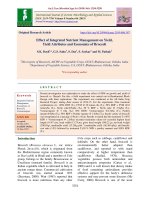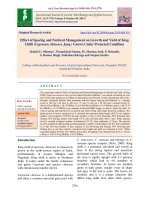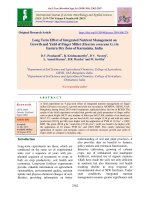Effect of integrated nutrient management on yield and yield attributes of pearl millet [pennisetum glaucum (L.) R. Br. Emend stuntz]Effect of integrated nutrient management on yield and
Bạn đang xem bản rút gọn của tài liệu. Xem và tải ngay bản đầy đủ của tài liệu tại đây (153.63 KB, 5 trang )
Int.J.Curr.Microbiol.App.Sci (2019) 8(10): 2733-2737
International Journal of Current Microbiology and Applied Sciences
ISSN: 2319-7706 Volume 8 Number 10 (2019)
Journal homepage:
Original Research Article
/>
Effect of Integrated Nutrient Management on Yield and Yield Attributes of
Pearl Millet [Pennisetum glaucum (L.) R. Br. Emend stuntz]
M. Samruthi, Rabindra Kumar*, Rajendra P. Maurya and Yalamati Sreeram Kumar
Department of Agronomy, Suresh Gyan Vihar University, Jaipur, Rajasthan-302017, India
*Corresponding author
ABSTRACT
Keywords
Vermicompost,
FYM, Biomix ,
RDF, Yield and
yield attribute
Article Info
Accepted:
20 September 2019
Available Online:
10 October 2019
A, field experiment was conducted at agriculture research farm, school of agriculture,
Suresh Gyan Vihar University, Jagatpura, Jaipur, Rajasthan during kharif season of the
year 2018 to ascertain the „effect of integrated nutrient management on yield and yield
attributes of pearl millet [Pennisetum glaucum (L.) R. Br. emendstuntz]. There were eight
treatments of different integrated nutrient management practices in randomized block
design replicated thrice. The result revealed that the grain and fodder yield of pear millets
were significantly exaggerated due to different treatment combinations. The maximum
effective tillers/m row length (25.36),ear head length(28.50 cm), test weight(7.53 g)), grain
yield (1905 kg ha-1), stover yield(5442 kg ha-1), biological yield(7347kg ha-1) and harvest
index(25.92 %), were obtained when pearl millet fertilized with 40% RDF along with
25% FYM+25% vermicompost+10% biomix of Treatment (T 7) where is the lowest value
was recorded in T0 (Control).
Introduction
Pearl millet is an important millet crop and
grown for both food and fodder purpose.
Cultivation of pearl millet is emphasized due
to its profuse tillering habit, multicut nature,
drought tolerance, resistance to insect pest and
disease, absence of poisonous prussic acid,
good performance even in poor soil, good per
day productivity leafiness, quick growing and
palatable to animal. The average nutrient
composition of the edible portion of the seed
is 67 % carbohydrates, 12.4 % moisture, 11.6
% protein, 3.5 % fat, 1.5 to 3.0 % fiber and 2.7
% minerals (Sharma and Burark, 2015). It is
the predominant rainfed crop and contributed
only 6 percent to the total food grain
production of the country. The reason for such
a low contribution can be attributed to the lack
of improved cultural practices; cultivation of
poor and marginal lands on low fertility and
poor or delayed germination due to soil
crusting. Hence with our research efforts
constraints responsible for poor yield should
be eliminated. Nitrogen fertilizer had played a
key role in increasing the food grain
production in India and continued to do so in
the future (Prasad, 2011) But several studies
show that nitrogen application can increase the
millet production efficiency, an adequate
2733
Int.J.Curr.Microbiol.App.Sci (2019) 8(10): 2733-2737
supply of nitrogen is associated with vigorous
vegetative growth (Ayub et al., 2009 and
Manan et al., 2006). Phosphorus is known to
stimulate extensive root system thereby
enabling the plant to uptake moisture and
mineral nutrients optimally. Vermicompost
reduces C: N ratio and also helps in increasing
the humus content of soil and provides plants
with a wide range of readily available
nutrients such as Nitrate, Phosphorus,
Potassium, Calcium, Magnesium (Talashikar
et al., 1999). Farmyard manure has play a role
in increasing fertility of the soil and improving
water holding capacity of the soil (Keerthanan
et al., 2018). Farmyard manure increased
nitrogen use efficiency of the crop and the
status of organic carbon, available N, P2O5
and trace elements in the soil and countering
deleterious fixing bacteria has been reported to
fix about 20 kg N / ha / year in non-legume
crop fields and also secretes some growth
promoting substances (Subbarao, 1982).
Phosphate
solubilizing
micro-organism,
particularly the soil bacteria belonging to the
genera Pseudomonas and Bacillus and fungi
belonging to the genera Penicillum and
Aspergillus possess the capability to transform
insoluble phosphate into soluble forms
(Alexander, 1977). Many crop scientists have
indicated
that
Vesicular
arbuscular
mycorrhiza (VAM) fungi are capable of
alleviating the adverse effect of drought on
plant growth and improves tolerance capacity
of plants against drought stress (Jayne and
Quigley, 2014).As no single farm input is
capable of supplying a balanced amount of
nutrients, the integrated use of all input
sources is a must to supply balanced nutrients
to plants (Hedge and Babu, 2004).
and tropic of cancer is 388 km. The average
annual rainfall of the region is about 500 to
700 mm which is mostly received between
July to August and 80 to 100 mm in
September. The average humidity of the tract
is about 65 per cent. The experiment was laid
out in Randomized Block Design (RBD) with
3 replications. The treatments comprised 8
combinations viz., Recommended dose of
fertilizer (60:30:0 NPK kg ha-1), 75 % Farm
yard manure + 25 % Biomix, 75 % RDF + 25
% Biomix, 70 % Vermicompost + 30 %
Biomix, 75 % RDF + 25 % FYM, 50 % RDF
+ 50 % Vermicompost, 40% RDF+ 25 %
FYM + 25 % Vermicompost + 10 % Biomix
and control. All agronomical practices were
followed during investigation period and
meteorological week wise weather parameters
were also observed. Pearl millet cultivar
“RHB-177” used as experimental materials
and sowing at 45×15 spacing in field. FYM,
Vermicompost and Biomix (Azotobacter,
Phosphate solubilizing bacteria and Vesicular
arbuscular mycorrhiza) were applied 10@
tonnes ha-1, 5 @ tonnes ha-1and 4 kg ha1
respectively as per treatments prior to
sowing. Urea was applied half dose at the time
of sowing and remaining half dose at
flowering stage as per treatment. Phosphorus
was applied before sowing as per treatment.
Five tagged plants from each plot were
selected randomly for recording different
observations. The statistical analysis of data
was done using analysis of variance
(ANOVA) technique at 0.05 probability level.
Materials and Methods
The result revealed that the number of
effective tillers per metre row length, Ear head
length and test weight of pearl millet were
significantly affected due to
different
integrated nutrient management treatments are
furnished presented in (Table 1). Application
The field experimental site was situated at
26.9° North latitude and 75.7° East longitude at
an altitude of 1417 meter above mean sea
level. The distance between Jagatpura, India
Results and Discussion
Yield attributes
2734
Int.J.Curr.Microbiol.App.Sci (2019) 8(10): 2733-2737
of 40% RDF along with 25% FYM+ 25%
Vermicompost+10% Biomix Treatment (T7)
produced significantly higher the effective
tillers per metre row length (25.36), ear head
length (28.50 cm) as compared to rest of all
the treatments. The minimum value of
effective tillers per meter row length
(18.00)and ear head length (18.76 cm)were
obtained under the treatment T0i.e(control).It
is evident that the test weight was not
significantly
influenced
by
different
treatments of integrated nutrient management.
However, the uppermost (7.53 g) test weight
was also observed under the treatment(T7)i.e.
40% RDF along with
25% FYM+25%
Vermicompost+10% Biomix) followed by
(7.43 g) under T6 (50% RDF+50%
Vermicompost) whereas, the lowest value
(6.46 g) of test weight was noted under
control (T0).
The increase in yield attributes may be
because INM application of fertilizer makes
more availability of nutrients which in turn
provides higher availability of nutrients to the
plant, the increased growth provided greater
sight for photosynthesis and diversion of
photosynthesis towards sink (ear and grain).
The application of biofertilizers led to a higher
availability of N and P2O5 as well as promoted
the root growth, which promoted yield
attributes characters.
Table.1 Effect of integrated nutrient management on yield attributes of pearl mill
Treatments
T0Control
T1 Recommended dose of fertilizer (60:30:0 NPK kg ha -1)
T2 75 % Farmyard manure + 25 % Bio mix
T3 75 % RDF + 25 % Biomix
T4 70 % Vermicompost + 30 % Bio mix
T5 75 % RDF + 25 % FYM
T6 50 % RDF + 50 % Vermicompost
T7 40 % RDF + 25 % FYM + 25 % Vermicompost + 10 %
Biomix
SE(m) ±
C.D at 5%
Effective tillers/m row
length
18.00
21.40
19.70
20.20
22.60
23.53
24.53
25.36
Ear head length (
cm)
18.76
20.86
20.80
22.96
22.26
24.60
27.46
28.50
Test weight
(g)
6.46
7.20
6.66
7.26
7.24
7.36
7.43
7.53
1.10
3.37
0.99
3.03
0.87
NS
Table.2 Effect of integrated nutrient management on yield of pearl millet
Treatments
T0 Control
T1Recommended dose of fertilizer (60:30:0 NPK kg
ha-1)
T275 % Farm yard manure + 25 % Bio mix
T375 % RDF + 25 % Bio mix
T470 % Vermicompost + 30 % Bio mix
T575 % RDF + 25 % FYM
T650 % RDF + 50 % Vermicompost
T740 % RDF + 25 % FYM + 25 % Vermicompost +
10 % Bio mix
SE(m) ±
C.D at 5%
Grain yield
(kg ha-1)
650
1160
Stover yield
(kg ha-1)
1834
3245
Biological yield
(kg ha-1)
2484
4405
Harvest index
(%)
26.16
26.33
1012
1283
1230
1402
1768
1905
3020
3503
3145
3837
5123
5442
4032
4786
4375
5239
6891
7347
25.09
26.80
28.11
26.76
25.65
25.92
61.50
188
197.70
605
280.59
859
1.17
NS
2735
Int.J.Curr.Microbiol.App.Sci (2019) 8(10): 2733-2737
The beneficial effect may also be due to an
increase in the supply of all the essential
nutrients by vermicompost and FYM that
might have resulted in manufacturing of food
and its subsequent partition towards the sink.
The findings of present investigations are
supported by Khan et al. (2000) and Kumar
and Gautam (2004) in pearl millet, Kumawat
and Jat (2005) in barley, Hashim et al. (2015)
in maize and Divya et al. (2017) in pearl
millet.
Yield
A perusal of data presented in (Table 2)
showed that different combinations of
fertilizers and manures caused a remarkable
effect on grain, stover and biological yield of
pearl millet over control. The maximum
grain and stover yield (1905 and 5442 kg ha-1)
was obtained in treatment T7 (40% RDF+25%
FYM+25% Vermicompost+10% Biomix)
followed by (1768 and 5123 kg ha-1) under T6
(50% RDF+ 50% Vermicompost) which is at
par. The minimum (650 and 1834 kg ha-1)
was recorded under T8 (control). A critical
review of data of biological yield revealed
that the treatment T7 (40% RDF+25%
FYM+25% Vermicompost+10% Biomix)
significantly increased the biological yield of
pearl millet followed by (6891 kg ha-1)under
T6 (50% RDF+ 50% Vermicompost) and both
treatments are at par. However, the lowest
biological yield (2484 kg ha-1) was recorded
under T8 (control).The result presented in
(Table 2) revealed that the different doses of
fertilizers/manures numerically improved the
harvest index of pearl millet but could not
bring any changes.
References
Alexander, M.(1977). John Wiely and Sons,
New York .Introduction to soil
microbiology, 2ndedn, 233.
Anonymous,
(2018).Indian
Economy
Survey.Area , Production and yield of
major Crops. Govt of India,
Ministry of finance, economic division, New
Delhi.
Divya, G.,Vani, K.P., Babu, S.,P. and Devi,
S.K.B. (2017). Impacts of cultivars and
integrated
nutrientmanagement
on
growth, yield and economics of summer
pearl millet.International journal of
applied
and
purescience
and
agriculture, 03 (7): 64-68.
Hashim, M., Dhar, S., Vyas, A.K., Pramehs,
V. and Bipin, K. (2015 b). Integrated
nutrient management in maize (Zea
mays)- wheat (Triticum aestivum)
cropping system. Indian Journal of
Agronomy, 60(3): 352-359.
Hedge, D.M. and Babu, S.N.S. (2004).Role of
balanced fertilization in improving crop
yield andquality.Fertiliser News, 49
(12):103-110.
Jayne, B. and Quigley, M. (2014). Influence
of on arbuscular mycorrhiza growth
and reproductive
Kachroo, D. and Razdan, R. (2006). Growth,
nutrient uptake and yield of wheat
(TriticumaestivumL.) as influenced by
biofertilizers and nitrogen. Indian
Journal of Agronomy, 51(1):37-39.
Khan, H., Jain, P.C. and Trivedi, S.K.
(2000).Nutrient management in pearl
millet (Pennisetumglaucum L.) under
rainfed condition.Indian Journal of
Agronomy, 45 (4): 728-731.
Kumar, N. and Gautam, R.C. (2004).Effect of
moisture conservation and nutrient
management practices on growth and
yield of pearl millet under rainfed
conditions.
Indian
Journal
of
Agronomy, 50: 200-202.
Kumawat, P.D. and Jat, N.L. (2005).Effect of
organic
manure
and
nitrogen
fertilization
on
productivity
of
barley.Indian journal of Agronomy,
50(3): 200-202.
Prasad, R.(2011).Nitrogen and food grain
2736
Int.J.Curr.Microbiol.App.Sci (2019) 8(10): 2733-2737
production in India. Indian journal of
fertilizers, 7(12):66-76.
Reddy, S., Naga Madhuri, K. V., Venkaiah,
K. and Prathima, T. (2016 a).Effect of
nitrogen and potassium on yield and
quality of pearl millet (Pennisetum
glaucum L.).International Journal of
Agriculture Innovations andResearch,
4(4): 678-681
Sakarvadia, H.L., Golakiya, B.A., Parmar,
K.B., Polara, K.B. and Jetpara, P.I.
(2012).Effect of nitrogen and potassium
on yield, yield attributes and quality of
summer pearl millet.An Asian Journal
of Soil Science,7(2): 292-295.
Singh, B., Kumar, A., Abrol, V., Singh, A.P.,
Kumar, J. and Sharma, A. (2018).
Effect of integrated plant management
on pearl millet (Pennisetum glaucum)
productivity in rainfed subtropic
Shiwalik foothills of Jammu and
Kashmir methods. Indian journal of
agronomy, 63(2): 197-200.
Subba Rao, N.S. (1982)..Oxford and IBH
Pub.Co.Biofertilizers in agriculture
.New Delhi.
Sharma, H. and Burark, S. S. (2015). Bajra
price forecasting in chomu market of
Jaipur district: An application of
SARIMA model. Agricultural situation
in India, 71:7-12.
Talashikar, S.C., Jadhav, M.B. and Savant,
N.G. (1999).Effect of calcium silicate
slag on plant growth, nutrient uptake
and yield of sugarcane on two soils of
Maharashtra state, India.Proceedings of
the conference on silicon in agriculture,
September
26-30,
1999,
Fort
Lauderdale, USA: 31-32
Keerthanan, P., Response of irrigated
blackgram to integrated nutrient
management. M.Sc. (Ag.) Thesis,
Annamalai University, Annamalainagar,
Tamil Nadu. (2018).
How to cite this article:
Samruthi, M., Rabindra Kumar, Rajendra P. Maurya and Yalamati Sreeram Kumar. 2019.
Effect of Integrated Nutrient Management on Yield and Yield Attributes of Pearl Millet
[Pennisetum glaucum (L.) R. Br. Emend stuntz]. Int.J.Curr.Microbiol.App.Sci. 8(10): 27332737. doi: />
2737
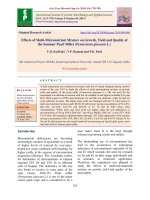
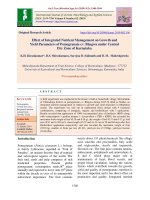
![Genetic analysis for micronutrients and grain yield in relation to diverse sources of cytoplasm in pearl millet [Pennisetum glaucum (L.) R. Br.]](https://media.store123doc.com/images/document/2020_01/13/medium_ion1578932058.jpg)

![Response of pearl millet [Pennisetum glaucum L. (R. Br.)] to integrated nitrogen management](https://media.store123doc.com/images/document/2020_01/14/medium_jyr1578949761.jpg)
![Production of interspecific hybrids between pearl millet [Pennisetum glaucum (L.) R. Br.] × Napier Grass [Pennisetum purpureum (K.) Schum] and their characterization](https://media.store123doc.com/images/document/2020_01/14/medium_rod1578988436.jpg)

